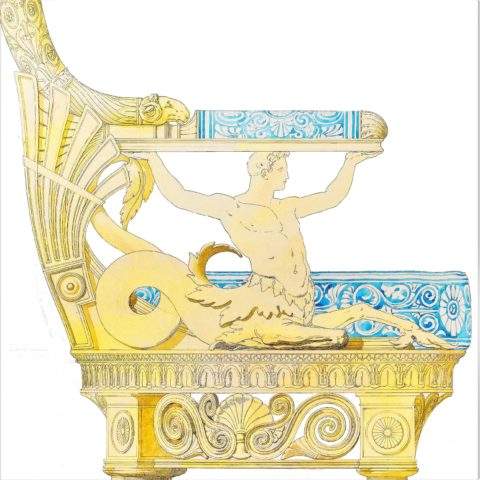Turin, Royal Museums dedicate major exhibition to Pelagio Palagi, painter and architect of the Savoy family
It is the eclectic Pelagio Palagi (Bologna, 1775 - Turin, 1860), draftsman, architect and painter, who is the protagonist of the Royal Museums’ autumn exhibition, entitled Pelagio Palagi in Turin. Memory and Invention in the Royal Palace, which from Nov. 9, 2019, to Feb. 9, 2020, delves into the Spazio Scoperte of the Galleria Sabauda (Savoy Gallery ) into the work carried out by the Bolognese architect in Turin, from 1832, as “Painter in charge of the decoration of the Royal Palaces” for Charles Albert of Savoy.
The Royal Palace of Turin is par excellence the place where Palagi’s art reached its highest expression: the architect refurbished the residence for the Savoy family, giving the structure a new and monumental appearance, aligned with the new requirements related to the sovereign’s great ambitions and court ceremonial. A work that today we could define as restyling, carried out also thanks to the collaboration of a team of painters(Francesco Gonin, Carlo Bellosio), sculptors and plasterers(Giuseppe Gaggini, Francesco Somaini, Diego Marielloni), cabinetmakers(Gabriele Capello known as the Moncalvo), and bronze workers ( Colla and Odetti firms , Manfredini and Viscardi).
The heart of the exhibition are the thirty-one sheets from the Archiginnasio Library in Bologna put in dialogue, where possible, with the works to which they refer. The exhibition route begins on the second floor of the Sabauda Gallery, precisely from the Spazio Scoperte. Alongside the design drawings relating to the Salone delle Guardie Svizzere (Swiss Guards’ Hall) and the main reception rooms, a number of works that were actually made and are still preserved in the Royal Palace will also be displayed. Specifically, the painting depicting St. Michael the Archangel (a model for a stained-glass window made in the Castle of Pollenzo), the taboretto carved in gilded wood and the rich figured candelabra in gilded bronze from the Hall of Private Hearings, testifying to the activity of the Palagiana team. The different projects, placed side by side, allow us to grasp Palagi’s stylistic characteristics, between classical recoveries and respect for Baroque pre-existences. Ample emphasis is given to the design of the neoclassical Ballroom, an authentic masterpiece of the artist, the design of a new Scalone d’Onore (never realized), and the rooms and furnishings of the Royal Armory.
The exhibition continues in the space adjacent to the Discovery Space, with the important designs for the rooms set up on the Second Floor of the Royal Palace for the wedding of Victor Emmanuel II that took place in 1842. Drawings for the gate, made in bronze in the Piazzetta Reale, and designs for the Gardens conclude this section of the exhibition. Finally, along the tour of the Piano Nobile of the Royal Palace it is possible to follow a true Palagian itinerary, with references to the drawings in the exhibition and guided tours also dedicated to rooms on the Second Floor, normally closed to the public, where the evocative rooms of the Salotto Blu and Salotto Rosso were completely refurbished by Palagi.
The exhibition is curated by Giorgio Careddu, Franco Gualano and Lorenza Santa of the Royal Museums, with the collaboration of Prof. Marinella Pigozzi of theUniversity of Bologna. Indeed, theUniversity of Bologna participated in the creation of the exhibition and its catalog with the School of Specialization in Historical and Artistic Heritage, which, as part of a training project that flowed into an internship, carried out a complete census of the Palagian fund relating to today’s Royal Museums. The fruit of this research will be published in the form of a registry along with the scientific records of the drawings on display, compiled for the occasion by the specialized students.
For all information you can visit the official website of the Royal Museums.
Source: press release
 |
| Turin, Royal Museums dedicate major exhibition to Pelagio Palagi, painter and architect of the Savoy family |
Warning: the translation into English of the original Italian article was created using automatic tools. We undertake to review all articles, but we do not guarantee the total absence of inaccuracies in the translation due to the program. You can find the original by clicking on the ITA button. If you find any mistake,please contact us.




























